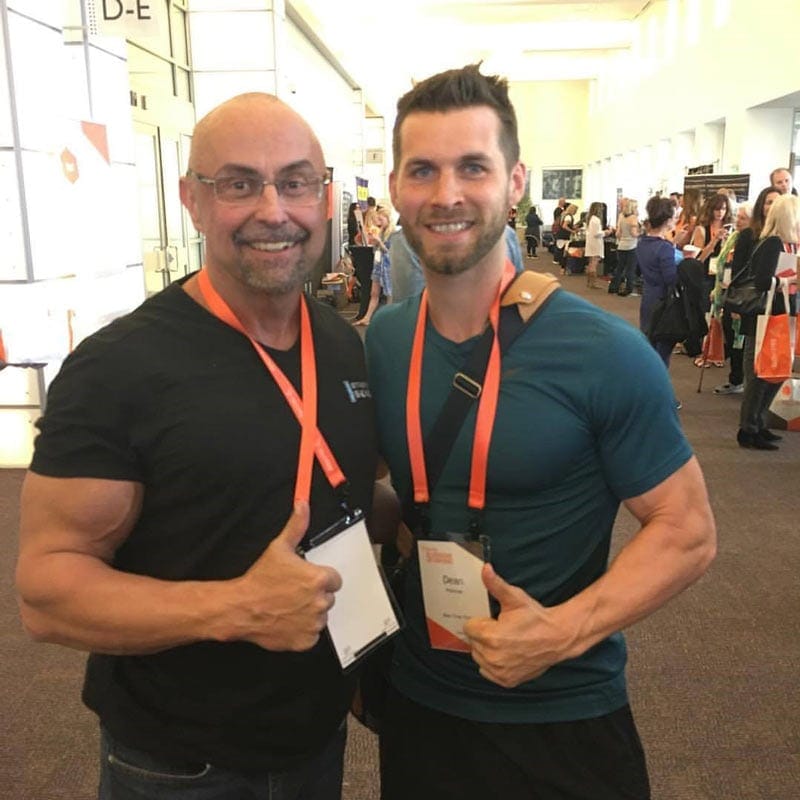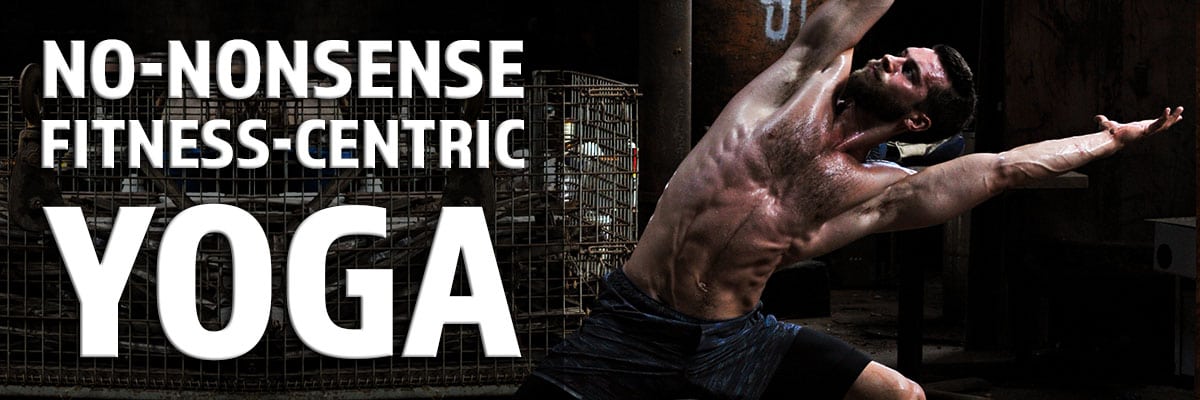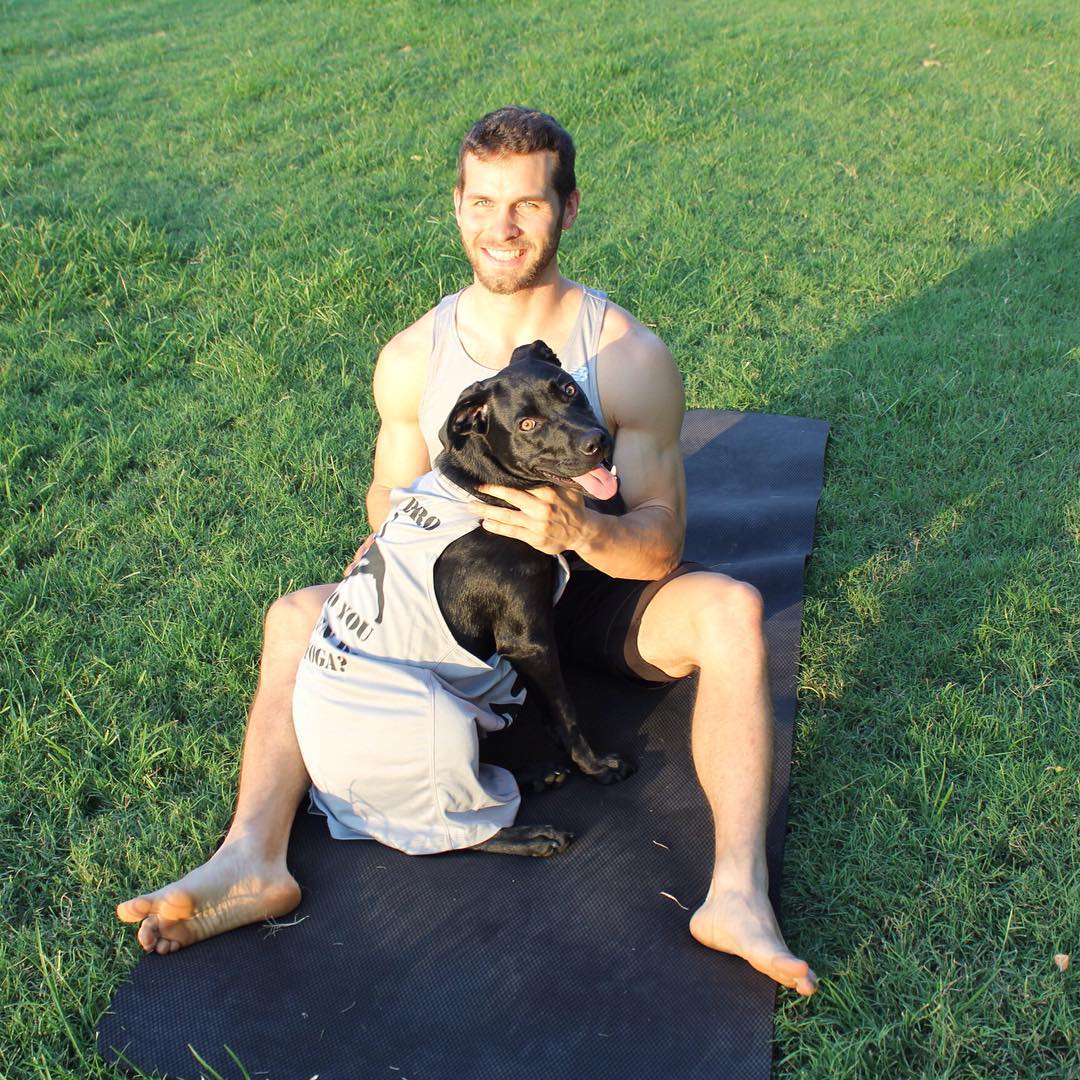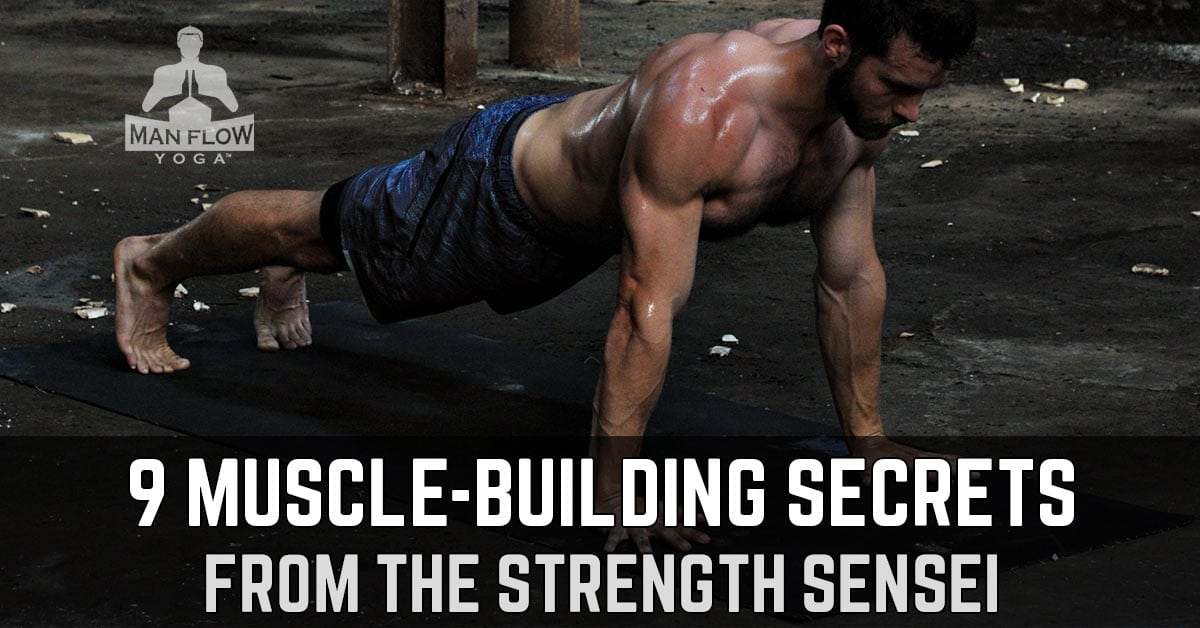A few weeks ago I attended the Bulletproof Conference in Pasadena, to learn about the most cutting-edge habits, practices, and technology to help improve your fitness, increase your performance, and keep you healthy in an incredibly unhealthy world.
 The most relevant talk I attended in terms of what I do with Man Flow Yoga was by far the open discussion Q&A session by Charles Poliquin, aka The Strength Sensei, one of the world’s most recognized strength training coaches. Poliquin has trained professional and olympic athletes, and has often been far ahead of the curve when it comes to designing effective training routines. Training principles that are just now in 2016 becoming mainstream knowledge have been part of Poliquin’s training programs since the 1970s.
The most relevant talk I attended in terms of what I do with Man Flow Yoga was by far the open discussion Q&A session by Charles Poliquin, aka The Strength Sensei, one of the world’s most recognized strength training coaches. Poliquin has trained professional and olympic athletes, and has often been far ahead of the curve when it comes to designing effective training routines. Training principles that are just now in 2016 becoming mainstream knowledge have been part of Poliquin’s training programs since the 1970s.
I chose the 9 most valuable lessons from Poliquin’s discussion, expanded on them, and organized them into THIS blog so you can learn more about some of the biggest strength training secrets, as told by the Strength Sensei himself – along with my commentary and annotations.
Ready to learn something that will change the way you approach your workouts? Let’s do it.
What’s your growth type?
Take a simple test to figure out how your body best responds to strength training methods
People tend to grow stronger in 3 ways, so what works for one person might not work for you. You need to experiment with your training and track your progress in order to figure out which is the best way for you to learn your most effective method for growing strength. Poliquin recommends using the Braverman Test, which you can find at bravermantest.net . Be warned – you can only take it once to accurately test yourself. After the first time you become biased and the results aren’t reliable. Here are the 3 ways people grow stronger:
- Volume – This is a function of weight and reps. If you lift 30 pounds 20 times, your total volume is 600 pounds. If you grow stronger in this way, it’s important to do as many reps as possible to grow stronger.
- Variety – I often say that the only way to get stronger is by doing things your body isn’t accustomed to. This means variety. In order for you to get stronger, you have to change up your training. Do new things.
- Intensity – Ramp up the intensity. Higher weight, higher heart rate. This doesn’t mean you have to do a high-intensity workout for 60 minutes – it just means you need to spend a few minutes working at a high-intensity in order to see better results.
Keep in mind that every strength training program should include a well-rounded variety of each of the above types, just that if you are looking for a more effective training program; the most bang for your buck, sort to speak, that it’s important to focus on whatever training method works best for you.
After you take the test, compare your results to the dominant types below:
- They are well-rounded athletes and thrive on stability, consistency, and routine. They are very sensitive to variations in routine; they need to vary intensity and volume in their approach.
Acetyl-Choline dominant – responds best to VARIETY
- Acetyl-Choline dominant athletes will do better with more consistency at lower volume. Going to the extreme end with high intensity workouts every time you strap-in could lead to burnout and a sense of overtraining. It’s important for these athletes to plan for recovery days.
Dopamine dominant – responds best to INTENSITY
- For a dopamine dominant athlete, a more varied and higher volume approach to sport will yield the greatest benefits. These athletes have an incredible capacity to adapt to movements, but if they don’t switch it up frequently, they will burn out.
Serotonin – You probably don’t enjoy working out, find whatever works for you.
- Tend to not gravitate towards sport, particularly those sports that have any type of high intensity or require a substantial amount of volume. They will focus more on their training plan than the training itself, and generally be more interested in different philosophies of the sport rather than actually going out and getting dirty. They may also resort to hacks or supplements to find the quick-fix solution. For these guys, it’s important to find something they enjoy and stick with it.
The different types of dominant-types above and their corresponding traits are paraphrased from a link I found below. Want to take a look at your results in more detail? Go here: https://www.theinertia.com/surf/the-five-elements-of-athlete-its-all-about-neurotransmitters/
Best supplement for weight loss?
Fish oils – but only certain types.
Fish oils are one of the best supplements you can take for sustained fat loss. It may sound like a lot, but it is recommended that you take 1 gram of fish per body fat %. So if you are trying to lower your body fat percentage, and you’re sitting at 23% right now, that means you should be taking 23 grams of fish oil per day. (Yup – that’s about 23 horse pills of fish oil. WHOA!) It seem like a lot, but science and data is a pretty cool thing, and we should listen to it. Also, fish oils have almost no side effects. The worst that happens is diarrhea, which rarely happens. (Check the sources below)
- https://jissn.biomedcentral.com/articles/10.1186/1550-2783-7-31
- https://www.ncbi.nlm.nih.gov/pmc/articles/PMC3635209/
However, not all fish oils are made the same. In fact, the fish oils you buy from the grocery store are probably useless. The best fish oils use a Norwegian filtration process, a technique which filters the fish oil twice using high-pressured CO2. The Strength Sensei recommends Pure Encapsulations or ATP Labs.
Krill oil or fish oil? I’ll leave that up to you. Both are awesome for you, krill oil may be a little bit better, but it’s potentially more harmful for the environment.
Do you pay attention to how fast you chew?
Chewing has a huge effect on your overall health. Studies discovered that overweight people chew just 15 times before swallowing, while thin/in-shape people chew 45-50 times before swallowing. Aside from weight management, there are many other reasons why you should chew your food more:
- You need to break down your food in order to absorb the nutrients properly, and your teeth do that. Chewing thus reduces stress on your stomach because your teeth do the work they’re supposed to be doing, instead of giving it all to the stomach.
- Chewing more and eating more slowly increases the alkalinity of the food, helping to balance your body’s pH levels and leading to a host of overall good health benefits, as well as disease prevention.
- Chewing more leads to less bloating. In other words, you won’t burp or fart as much. A definite plus for those family dinners or first dates.
- You can use this as an opportunity to relax. We spend most of our day hurrying from one task to the next, and focusing on chewing slowly and relaxing helps your mind and your body manage stress, recover, and recharge.
Here are some tips to making sure you’re chewing enough:
- Take some time during your next meal to practice chewing more. Count in your head from 1 to 50 total chews before swallowing, or use a clicker to measure the total number of chews.
- Avoid mindless eating. Don’t eat if you’re watching TV or browsing on your phone. If you’re not concentrating on chewing, you’ll probably chew too few times and swallow too fast without thinking about it.
- If you eat with your family, friends, or partner, take a bite and then spend 50 chews focused on listening to what he/she/they is (are) saying. Not only will you manage weight better and get healthier, but you’ll also listen better and build a better relationship with the people around you.
You have to earn the exercise with the necessary mobility before doing it.
If you don’t have the mobility to do a proper squat, then spend your time improving your mobility instead of working on squats with improper form. I really liked the way Charles put this when he said, “You have to earn the exercise before you can do it.” When he says “earn”, he refers to having the necessary amount of mobility.
This makes a lot of sense. When people lack the mobility to do a certain exercise, they make up for that lack of mobility by overusing another muscle group. In order to train properly, you need to ensure that all muscles required for the exercise are being used. When you lack mobility; when you lack the ability to actively engage and utilize the muscle in the necessary range of motion, then you are contributing to muscular imbalances, severely limiting your strength potential, and setting yourself up for discomfort, pain, or injury.
Here are a few examples:
- Lack of hamstring mobility in a deadlift -> Curvature and strain on the lower-back.
- Lack of ankle mobility in squat -> Heels coming off the ground, glutes not engaged in a squat.
- Feet not facing straight forward in a squat -> This means your glutes won’t engage.
- Lack of shoulder mobility in overhead press -> Leads to muscle imbalances in the upper-body, puts strain on the rotator cuff, and prevents proper core engagement.
Fortunately, there are many ways to improve your mobility. Yoga is the easiest, but there are some other faster ways, too, if you can handle some brief discomfort.
What’s the fastest way to increase mobility?
The fastest way to increase mobility is not through yoga (although yoga should be part of your routine in order to maintain mobility – as well as a few hundred other reasons which I won’t go into now) but actually through myofascial release, accupuncture, active release therapy, or dry needling. Myofascial release you can practice yourself (I provide a ton of these workouts and tutorials in the Man Flow Yoga Members’ Area and some of them you can see on my YouTube channel), though it is less effective than the other three, and in order for sustained results using any of the mentioned practices here it is necessary to incorporate mobility practice into your training routine on a very regular basis. Yoga satisfies that need quite nicely, and I recommend doing at least 100 minutes per week (you can spread that 100 minutes out however you’d like).
If you haven’t started yoga yet, and would like to learn yoga in a way that complements your fitness training, sign up for my 7-Day Challenge.
This free course teaches you the most effective postures to gain strength, improve mobility, fix your posture, strengthen your core, build balance, and more. No Credit Card Required!!!
Signup for the FREE 7-Day Challenge
What should I have before a workout?
The best pre-workout foods to help increase strength gains are the ones that raise dopamine levels, and these include red meat, nuts, avocados, or blueberries. Eat these about 1 hour before your workout. By far the most effective of these are meat and nuts, but if for practical or personal reasons those are not an option, then avocados or blueberries will also work.
This does not meant that you should gorge yourself with red meat before a workout to the point you can barely move. It just means have a little bit of it to provoke the dopamine response from your body, give yourself about 60 minutes (more or less depending on your fitness level and metabolism) for your body to digest it, and then get to your workout.
Does cardio help with weight loss?
(The shocking answer)
If your goal is weight loss or longevity, stop doing cardio. Our body is designed to function best with strength, not with speed. Charles describes this with the following: We evolved to kill our prey by throwing a rock at it, not by chasing it down. Not only that, but the science also tells us that cardio isn’t great for us. If we change nothing, but start doing slow-medium paced cardio 1 hour per day, we actually INCREASE total body fat percentage.
Note for endurance athletes: Now this is completely different for a runner, triathlete, or competitor whose goal it is to compete in a cardio-focused activity or event. But, it does mean that those individuals need to ensure they are supplementing their training with the necessary strength work to ensure they retain muscle mass, keep body fat percentage low, and reap all of the benefits that go with it.
Some other notes about cardio:
- Cardio makes your brain age faster.
- HIIT (high intensity interval training) is NOT cardio. Cardio refers to an activity you can do while still being able to carry on a conversation.
- Cardio in the form of running puts a ton of stress on your joints, wears out your cartilage, and is a relatively ineffective use of workout time. (You get much more out of strength training, without the stress on your body.)
How does strength training help with fat burn?
Strength training decreases total body fat percentage, improves sleep, raises testosterone, lowers stress… the benefits go on and on, and all of the benefits I’ve mentioned so far combine to form a cycle that CONTINUES to burn fat. Sleeping more helps you burn more fat. Raising testosterone levels helps you burn more fat. Building more muscle burns fat, and so on and so on…
Building muscle is one of the (if not THE) most important aspects of your fitness you should be concerned with when it comes to your training, and this means avoiding exercises that aren’t as effective or detract from the goals of building muscle.
Strength training and building muscle also leads to a higher number of insulin receptors, and increases their sensitivity. This is important because having increased insulin sensitivity means that:
- Your body is less likely to store fat.
- You sleep better. (And have more energy, less fatigue.)
- You’re less at risk of Diabetes.
- You lower your chance of heart disease.
- And of course, a bunch of benefits I won’t list here.
How does yoga complement strength training?
Poliquin didn’t say anything about yoga in particular, but based on what I heard I think Poliquin would say it’s important because of the mobility aspect. As we age, mobility is the first aspect of our fitness to go. Unless we are spending time on mobility, we won’t retain it. Using practices like myofascial release (MFR), dry needling, acupuncture, or active release therapy are useful for helping us increase mobility quickly, but yoga causes much less stress on the muscles and requires less recovery time. So I would recommend starting with a combination of yoga and mobility practices in order to improve your mobility, but with the goal of transitioning to a mobility program that is MOSTLY yoga, and supplemented with mobility practices such as this listed above.
So if you know you’re pretty inflexible and need to work on your mobility, the fastest and most effective way to increase would be through practices that require assistance form others, but your goal should be to get to the point where your mobility levels are adequate so you can maintain your mobility on your own (for the most part). That’s not to say that regular massage therapy sessions aren’t off the table, but it does mean that you don’t have to schedule an appointment 3x a week in order to keep up with your fitness routine.
I hope you’ve enjoyed this blog! Let’s sum it up below:
- Take the Braverman Test, figure out how your body best responds to training, and create a program based on that.
- Take high quality fish oils.
- Chew 45-50 times before swallowing.
- Get the necessary mobility levels before doing the exercise.
- Increase mobility as fast as possible with accupuncture, myofascial-release, and active release therapy; maintain and increase it with yoga.
- Eat foods that provoke a dopamine response about 1 hour before your workout for the best pre-workout fuel.
- Avoid a cardio-based program if you want to lose weight.
- Strength training is the most effective form of exercise for burning fat.
- Yoga complements strength training by improving muscle activation, improving and maintaining necessary mobility levels, and aiding in recovery. (There are many more direct and indirect methods, but we won’t list those here.)
About the author, Dean Pohlman, Founder & CEO of Man Flow Yoga, Author of Yoga Fitness for Men, Expert on Yoga Fitness for Men.
Looking for non-spiritual, yoga for men workouts?
Learn More About Man Flow Yoga and how it can help you with your fitness goals:
 Join Today for Instant Access!
Join Today for Instant Access!



I love your emails and blogs, Dean…. In my opinion, cardio gets a bad rap because it is a very vague term. The bad cardio is done above a heart rate 50% aerobic / 50% anaerobic for a extended period of time; for most people that is approx. 180 – your age (MAF Heart Rate). Heart rates above 180 – age is where your body switches to burning carbohydrates for fuel instead of stored fats. This cardio is not good for your hormones, heart, causes high stress, and massive cortisol response (hence the fat retention). This is where interval training and hits training plays an important role. Allowing your heart rate come down between higher intensity intervals is the key…. Anyways, In addition to a good strength program; good cardio is done at below 180 – age heart rates (conversational pace). Like with hit training your body learns to burn fat for fuel. It also can be a stress reliever. Reducing stress and burning fat for fuel in my opinion is the key for health and weight loss. Which type of exercises you should focus on for losing weight should be based on what you enjoy and how much time you have to exercise (hit training takes less time). In my opinion cardio done right is a great weapon for increased health and weight loss. Just my 2 cents. Keep all the good info coming Dean, thank you!!!!
Hey Ryan – appreciate your response! Yes, there are a ton of members like you who are runners, triathletes, or other endurance athletes. It’s good to hear from you. The 180 – age rate formula is something I heard from Mark Sisson and the Primal Blueprint. Thank you for the information re: letting the heart rate come down and maintaining that lower pace.
So basically we need to make sure we’re not just doing cardio and trying to kill ourselves in the process, but following a systematic approach.
Exactly! To many people, myself included, have been taught more is better and harder is better, which both can be if done properly. Two much HIT training or improper HIT training will have the same negative effects to your health as too much high intensity cardio or too much low intensity cardio for that matter. Variety is the spice of life, but you must perform your workouts correctly and with purpose to get the results at which you aim. The two most important things I have learn from listening to the experts like you, Dean, is you really need to learn to listen to your body, and fitness/health needs to be a sustainable lifestyle. So eat right and do what you love, but do it correctly and in a healthy manner. The fat loss will follow. To things have changed my health the most. One is slow cardio and the other is Man Flow Yoga. That doesn’t mean I don’t love a good HIT workout or what works for me will work for everyone…… Anyways Sorry to rant, but I am pretty sure my wife didn’t want to hear my opinions on health and fitness this morning. LOL
Wow! Thank you for sharing these valuable muscle-building tips. It means a lot to me, as a beginner this one inspires me to continue and be passionate about muscle building and be fit. Keep sharing more healthy tips articles like this.